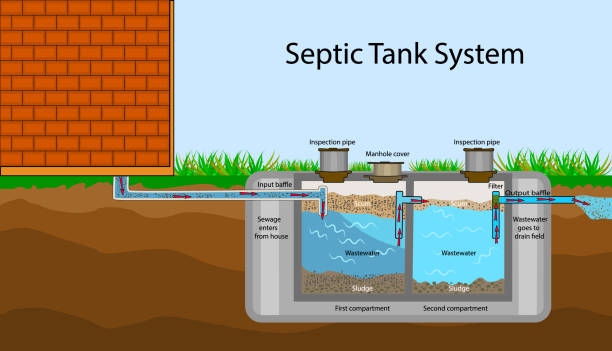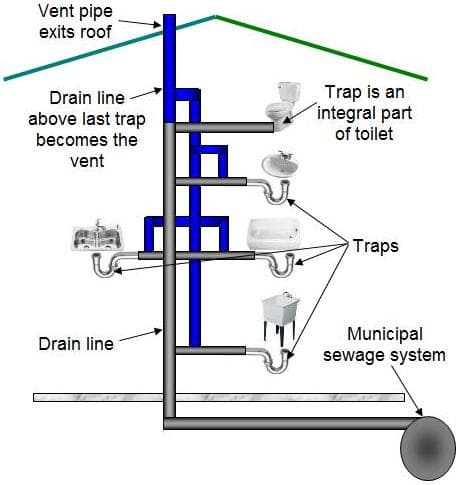Exploring Your Home's Plumbing System Anatomy
Exploring Your Home's Plumbing System Anatomy
Blog Article
What are your ideas about The Inner Workings of Your Home's Plumbing?

Understanding just how your home's pipes system works is necessary for every house owner. From delivering clean water for alcohol consumption, cooking, and showering to safely getting rid of wastewater, a well-kept plumbing system is crucial for your family members's health and convenience. In this comprehensive guide, we'll check out the intricate network that comprises your home's plumbing and deal pointers on upkeep, upgrades, and dealing with usual issues.
Intro
Your home's pipes system is greater than just a network of pipes; it's an intricate system that guarantees you have accessibility to clean water and reliable wastewater removal. Knowing its parts and just how they collaborate can aid you stop costly fixings and ensure everything runs smoothly.
Basic Parts of a Pipes System
Pipes and Tubes
At the heart of your plumbing system are the pipelines and tubing that lug water throughout your home. These can be made of numerous products such as copper, PVC, or PEX, each with its advantages in regards to durability and cost-effectiveness.
Components: Sinks, Toilets, Showers, etc.
Fixtures like sinks, commodes, showers, and bathtubs are where water is made use of in your home. Recognizing just how these fixtures attach to the plumbing system helps in identifying problems and preparing upgrades.
Shutoffs and Shut-off Factors
Valves regulate the flow of water in your pipes system. Shut-off valves are critical during emergencies or when you require to make repairs, enabling you to separate parts of the system without interfering with water flow to the entire home.
Supply Of Water System
Key Water Line
The primary water line connects your home to the metropolitan supply of water or an exclusive well. It's where water enters your home and is distributed to numerous fixtures.
Water Meter and Stress Regulator
The water meter actions your water usage, while a stress regulator makes certain that water streams at a safe stress throughout your home's pipes system, stopping damage to pipelines and components.
Cold Water vs. Hot Water Lines
Comprehending the distinction between cold water lines, which provide water directly from the major, and hot water lines, which lug heated water from the hot water heater, assists in troubleshooting and preparing for upgrades.
Drain System
Drain Water Lines and Traps
Drain pipes lug wastewater away from sinks, showers, and commodes to the drain or septic system. Traps stop sewage system gases from entering your home and also catch debris that can create blockages.
Ventilation Pipelines
Ventilation pipes permit air into the water drainage system, stopping suction that could slow drain and cause traps to vacant. Appropriate air flow is vital for preserving the integrity of your pipes system.
Significance of Correct Drain
Ensuring appropriate drainage stops backups and water damage. On a regular basis cleaning drains pipes and keeping catches can avoid expensive fixings and expand the life of your pipes system.
Water Furnace
Sorts Of Hot Water Heater
Hot water heater can be tankless or traditional tank-style. Tankless heating systems warmth water on demand, while storage tanks keep warmed water for prompt usage.
Just How Water Heaters Attach to the Pipes System
Recognizing how hot water heater attach to both the cold water supply and warm water circulation lines aids in detecting problems like not enough hot water or leaks.
Maintenance Tips for Water Heaters
Routinely flushing your water heater to remove sediment, checking the temperature settings, and evaluating for leakages can expand its life expectancy and enhance energy efficiency.
Typical Pipes Issues
Leakages and Their Reasons
Leakages can happen due to maturing pipelines, loose installations, or high water stress. Dealing with leakages promptly avoids water damage and mold development.
Clogs and Blockages
Blockages in drains and commodes are typically caused by purging non-flushable items or a build-up of grease and hair. Using drainpipe screens and bearing in mind what decreases your drains can stop obstructions.
Indications of Plumbing Problems to Look For
Low water stress, slow drains pipes, foul odors, or unusually high water costs are indicators of possible plumbing issues that need to be attended to immediately.
Pipes Upkeep Tips
Regular Assessments and Checks
Schedule yearly plumbing assessments to capture issues early. Search for indications of leakages, corrosion, or mineral accumulation in taps and showerheads.
Do It Yourself Maintenance Tasks
Basic tasks like cleaning tap aerators, checking for bathroom leaks making use of dye tablet computers, or shielding subjected pipelines in cold environments can protect against significant pipes concerns.
When to Call a Professional Plumbing Technician
Know when a plumbing problem needs expert experience. Attempting complicated fixings without correct knowledge can lead to more damage and higher fixing prices.
Updating Your Pipes System
Reasons for Updating
Updating to water-efficient fixtures or replacing old pipes can improve water top quality, lower water costs, and raise the worth of your home.
Modern Plumbing Technologies and Their Benefits
Explore technologies like clever leakage detectors, water-saving bathrooms, and energy-efficient water heaters that can save money and minimize ecological effect.
Cost Considerations and ROI
Calculate the upfront costs versus lasting cost savings when considering pipes upgrades. Numerous upgrades pay for themselves with decreased utility costs and less fixings.
Environmental Impact and Conservation
Water-Saving Components and Home Appliances
Installing low-flow faucets, showerheads, and bathrooms can significantly lower water use without giving up efficiency.
Tips for Reducing Water Usage
Basic behaviors like dealing with leakages quickly, taking shorter showers, and running complete lots of laundry and dishes can preserve water and lower your energy expenses.
Eco-Friendly Plumbing Options
Take into consideration sustainable plumbing products like bamboo for flooring, which is durable and eco-friendly, or recycled glass for counter tops.
Emergency Readiness
Actions to Take During a Plumbing Emergency
Know where your shut-off valves are located and how to switch off the water system in case of a burst pipeline or major leakage.
Value of Having Emergency Situation Contacts Convenient
Keep call information for neighborhood plumbers or emergency services easily available for fast feedback during a plumbing crisis.
DIY Emergency Situation Fixes (When Appropriate).
Short-lived repairs like making use of duct tape to spot a leaking pipeline or putting a bucket under a leaking faucet can lessen damages until a specialist plumbing gets here.
Verdict.
Comprehending the makeup of your home's plumbing system encourages you to maintain it properly, saving money and time on repairs. By complying with routine maintenance routines and remaining notified concerning modern-day plumbing modern technologies, you can guarantee your pipes system operates effectively for many years ahead.
HOW YOUR PLUMBING SYSTEM WORKS
Which Pipes Do What?
Blue lines = fresh water supply entering the building
Red lines = hot water supply entering the building
Grey lines = pipes carrying waste away from the building and venting pipes carrying gases away from the building (through the roof)
YOUR MAIN PLUMBING SYSTEMS
There are two main plumbing systems that support your home s basic plumbing needs one that brings clean water into your home, and one that sends dirty water away from your home. Connected to the toilet, bath, shower, and other faucets in your home, these two systems keep your water flowing in the right directions.
ACCESSING FRESH WATER
Fresh and clean water is brought into your home through the main water supply line . Filtered through one pipe, this water is pressured to flow into the various fixtures in your home at any given time.
This water can be sourced from a well located on your property, a pond or river (mostly cottages), or, as in most cases, from the city s municipal water treatment centre. However, it is important to note that water that is untreated, such as the water siphoned from ponds or rivers, may not be safe to drink. Personal water supplies always need to be treated for hardness and contaminants before consumed.
MUNICIPAL WATER SUPPLIES
Improve taste and odour
Remove sediment
Eliminate hardness
Reduce chlorine
COLD WATER SUPPLY VS. HOT WATER SUPPLY
Cold water flows into your home or building through the service line, which then distributes hot or cold water to your fixtures. This line is most commonly run through a central column that runs floor to floor. Hot water runs in short and straight pipes as the longer the pipeline, the more heat that will be lost in the transfer. Having shorter pipes also allows residents to access hot water more quickly.
WASTE WATER SYSTEM
Your wastewater system is divided into two parts pipes that send wastewater away from your home and venting pipes that send sewer gas away from your home. Sewage water travels through pipes that flush the water and waste towards local sewers that are operated and managed by your city or town. Most sewer systems rely on gravity to move the wastewater to where it needs to go.
The further away from your toilet or sink, the larger wastewater pipes become. This allows for waste to be disposed of from various parts of your home or business at once without pipe blockages. The angle and flow of these pipes are also essential for keeping your waste pipes clear of build up.
https://harrisplumbing.ca/how-your-home-plumbing-system-works/

HOW YOUR PLUMBING SYSTEM WORKS
Which Pipes Do What?
YOUR MAIN PLUMBING SYSTEMS
There are two main plumbing systems that support your home s basic plumbing needs one that brings clean water into your home, and one that sends dirty water away from your home. Connected to the toilet, bath, shower, and other faucets in your home, these two systems keep your water flowing in the right directions.
ACCESSING FRESH WATER
Fresh and clean water is brought into your home through the main water supply line . Filtered through one pipe, this water is pressured to flow into the various fixtures in your home at any given time.
This water can be sourced from a well located on your property, a pond or river (mostly cottages), or, as in most cases, from the city s municipal water treatment centre. However, it is important to note that water that is untreated, such as the water siphoned from ponds or rivers, may not be safe to drink. Personal water supplies always need to be treated for hardness and contaminants before consumed.
MUNICIPAL WATER SUPPLIES
COLD WATER SUPPLY VS. HOT WATER SUPPLY
Cold water flows into your home or building through the service line, which then distributes hot or cold water to your fixtures. This line is most commonly run through a central column that runs floor to floor. Hot water runs in short and straight pipes as the longer the pipeline, the more heat that will be lost in the transfer. Having shorter pipes also allows residents to access hot water more quickly.
WASTE WATER SYSTEM
Your wastewater system is divided into two parts pipes that send wastewater away from your home and venting pipes that send sewer gas away from your home. Sewage water travels through pipes that flush the water and waste towards local sewers that are operated and managed by your city or town. Most sewer systems rely on gravity to move the wastewater to where it needs to go.
The further away from your toilet or sink, the larger wastewater pipes become. This allows for waste to be disposed of from various parts of your home or business at once without pipe blockages. The angle and flow of these pipes are also essential for keeping your waste pipes clear of build up.
https://harrisplumbing.ca/how-your-home-plumbing-system-works/
We were made aware of that article on Anatomy of a House: Understanding the Components through a friend on our other web property. Make sure you set aside a second to distribute this article if you liked it. Thanks a lot for going through it.
View More Report this page